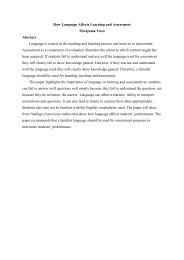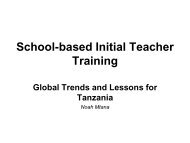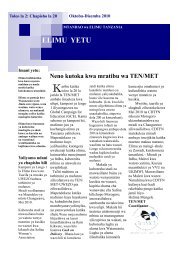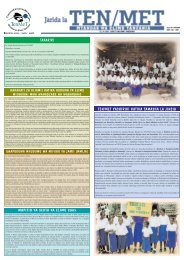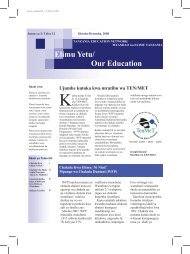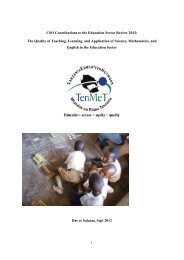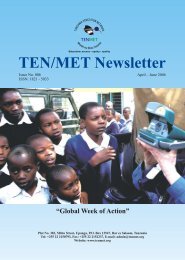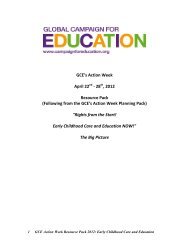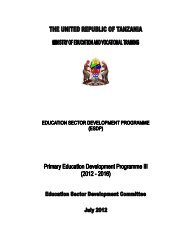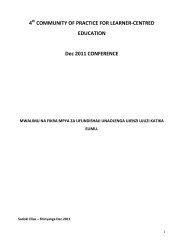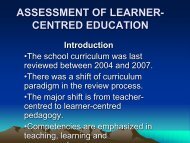Literacy POSITION PAPER.pdf - Tanzania Education Network ...
Literacy POSITION PAPER.pdf - Tanzania Education Network ...
Literacy POSITION PAPER.pdf - Tanzania Education Network ...
You also want an ePaper? Increase the reach of your titles
YUMPU automatically turns print PDFs into web optimized ePapers that Google loves.
YOUTH AND ADULT LITERACY IN TANZANIA:A Position Paper for GWA 2009April 2009
Table of ContentsYOUTH AND ADULT LITERACY IN TANZANIA: ......................................................... 3Introduction .......................................................................................................................... 3Background .......................................................................................................................... 4Policy Context....................................................................................................................... 7Implementation of Primary <strong>Education</strong> Development Plan (PEDP)................................ 8Complementary Basic <strong>Education</strong> in <strong>Tanzania</strong> (COBET) ................................................ 8Integrated Community Based Adult <strong>Education</strong> (ICBAE) ............................................... 9YES I CAN Model ................................................................................................................ 9NGOs’ Initiatives ............................................................................................................... 10CONCLUSION .................................................................................................................. 10REFERENCES ................................................................................................................... 12FACT SHEET .................................................................................................................... 132
YOUTH AND ADULT LITERACY IN TANZANIA:A Position Paper for GWA 2009 1IntroductionThere are many challenges to the delivery and attainment of quality basic education in<strong>Tanzania</strong>. These include, but are not limited to poor school infrastructure (includingsubstandard classrooms, and lack of laboratory and library facilities), unqualified teachers,long distances to schools, irrelevant curricula, inadequate teachers‟ in-service training,insufficient teaching and learning material, lack of food for pupils while at school, andgenerally poor nutrition. Furthermore, the high girls‟ dropout rate and inadequate adulteducation provision are impediments to educational inclusion. To address these challengesTEN/MET has put in place measures to influence education policy formulation andimplementation, including preparation and publication of policy briefs and position papers onkey education issues.This year (2009) will see the 10th annual Global Action Week in which education activistswill build the case for youth and adult literacy. The theme for this year is „Youth and Adult<strong>Literacy</strong> and Lifelong Learning‟. TEN/MET members will be calling upon the government totake action on literacy by allocating resources and reviving literacy classes, and generallyputting literacy on the national agenda. UNESCO reports that literacy is “one of the mostneglected of the six “<strong>Education</strong> For All” goals”. Most education programmes focused onprimary education and adult literacy have been neglected, resulting in a huge number ofilliterate adults. The majority of illiterate adults are found in less developed countries andwomen tend to be represented highly in this group. 2 According to the most recent UNESCOInstitute for Statistics (UIS) data, there are an estimated 774 million illiterate adults in theworld, about sixty-four per cent of whom are women. 3In line with this year‟s GWA theme, TEN/MET would like to launch a series ofsituation/policy analysis briefs and position papers to stimulate a broader, more open publicdebate on youth and adult literacy in order to influence policy and practice. This positionpaper assesses the current status and progress of Youth and Adult <strong>Literacy</strong> work in <strong>Tanzania</strong>.1 This paper was first drafted by Leonia Kassamia of Institute of Adult <strong>Education</strong> (Research, Planning andPublications Unit)2 See UNDP Human Development Report 2007/83 See UNESCO Institute for Statistics athttp://www.uis.unesco.org/ev.php?URL_ID=6401&URL_DO=DO_TOPIC&URL_SECTION=2013
BackgroundIn <strong>Tanzania</strong>, the provision of youth and adult literacy programmes has been an importantaspect of the government‟s educational policy since the 1960s. At independence, illiteracywas conceptualized generally as a cause of poverty, ignorance, oppression, disease, andexploitation. Adult education was conceived to have a liberating function to arouse popularconsciousness for change and providing a framework through which these constraints couldbe transformed. This was emphasized by the late Mwalimu J.K. Nyerere, the first president of<strong>Tanzania</strong>, in 1969 when he remarked.“People’s lives can only be improved by their own efforts and through their ownunderstanding. And, against the background of ignorance and poverty which weinherited at independence, this means that adult education of all types is of vitalimportance for rapid development” (IAE, 1969 pp. 8 – 9)In 1967, the government established Work Oriented <strong>Literacy</strong> Pilot Project in the Lake Zone.The evaluation showed that the project was very successful in reducing the illiteracy rate. Asa result, adult education programmes received considerable support from the ruling party andthe government leadership. The leadership took part in adult education activities thateducated and mobilized people through literacy programmes. Directives were issued callingupon the people to eradicate illiteracy. Hence the government launched a nation–wideliteracy campaign in 1971 aimed at eradicating illiteracy in the country by 1975. Evaluationconducted in 1975 showed that the government managed to reduce the adult illiteracy ratefrom 67% in 1971 to 39% in 1975 and down to 9.6% in 1986.Table 1: <strong>Literacy</strong> Rates as Measured by the National <strong>Literacy</strong> Tests, 1975 – 1992The figures for 1992 in Table 1 indicate a higher percentage (87%) for males than females(81%). Between, 1975 and 1992, the rates show an increasing literacy trend up to 1986 and adecrease of 6.4% from 1986 to 1992.In Table 2 below a female-male literacy gap was computed (last column) by dividing thefemale rate by that of males. This is a rough indicator of gender inequality in past efforts toprovide basic education. All the ratios are less than one, suggesting that in all regions of the<strong>Tanzania</strong> mainland, females have a lower rate of literacy than males.Table 2: <strong>Literacy</strong> Rates by Region, Sex and Female/Male Gap, 1995.4
Region Male Female Total Female/Male GapArusha 76.0 68.0 72.0 0.89Dar es Salaam 97.4 95.3 96.4 0.98Dodoma 86.1 78.7 82.3 0.91Iringa 89.4 83.5 86.2 0.93Kagera 85.0 79.7 82.1 0.94Kigoma 83.8 72.9 77.8 0.87Kilimanjaro 96.7 94.1 95.3 0.97Lindi 91.0 86.5 88.6 0.95Mara 90.6 85.4 87.7 0.94Mbeya 82.4 76.6 79.3 0.93Morogoro 86.7 85.0 85.8 0.98Mtwara 82.4 77.2 79.6 0.94Mwanza 85.6 80.6 82.7 0.94Pwani 86.9 80.5 83.6 0.93Rukwa 85.5 71.7 78.4 0.84Ruvuma 96.7 94.4 95.4 0.98Shinyanga 71.5 65.0 68.1 0.91Singida 80.6 72.9 74.4 0.90Tabora 89.8 86.0 87.8 0.96Tanga 92.7 88.3 90.4 0.95Total 86.9 81.5 84.0 0.94Table 2 also shows that much remains to be done in Shinyanga, Singida, Kigoma, Rukwa,Mbeya and Arusha regions which have over 20% illiteracy rates.After the 1975 evaluation, it was considered necessary to introduce post-literacy programmesfirst, to prevent neo-literate from relapsing into illiteracy, second, to enable neo-literates tocontinue to use literacy skills in their economic pursuits; and third, to create adequate literacyenvironment and facilities for the provision of life long education in the country (Mpogolo,1980). Post-literacy programmes were therefore, introduced in the mid-1970s with emphasis5
on both theoretical and practical aspects. Compulsory subjects were: Kiswahili, Mathematics,Political <strong>Education</strong>, and Agriculture. Optional subjects comprised Political Economy,History, Geography, Health, English, Crafts and Home craft.Moreover, a number of literacy supporting programmes (radio and film education, ruralnewspapers, rural libraries, workers education and folk development colleges) wereestablished with the aim of sustaining acquired literacy skills of reading, writing andarithmetic.Following a growing trend in privatization and liberalization policies that took place in the1980s, the country‟s development strategy, focussing on growth and equity, was abandonedin favour of a planned development strategy that focused more on growth and efficiency.Adult education including adult literacy was no longer central to development initiatives andthis was reflected in important agenda in political spheres. There is enough evidence todemonstrate that for a couple of years now both literacy and post-literacy programmes havenot been operating well.At the onset of EFA, the illiteracy rate in <strong>Tanzania</strong> (adults 13+ years old) was estimated to be28% and its rate was increasing by 2% annually. Enrolment figures dropped from 6.2 millionin 1986 to 1.2 million in 1990. It is estimated that the literacy rate had dropped to 68% by1998.The following were the shortfalls experienced during this time in adult literacy work in thecountryfailure to sustain the literacy rate, which dropped from 90.4% in 1986 to 68% in 1998due to poor equipment and material and a lack competent teachers, the problem ofdonor dependency, and perceived negative value of education.poor enrolment trend from 6.2 million in 1986 to 1.2 million in 1990s;failure of the functioning of literacy classes due to the economic crisis, which forcesadult learners to resort to income-generating activities;problems facing the adult literacy programme in terms of relevance management,funding and low morale among adult literacy instructors;Women were greatly disadvantaged in relation to men as they tend to be excludedfrom adult education programmes. The programme did not equip them with practicalknowledge and skills needed to make them functional in households and incommunities;literacy instructors not gender sensitized and not trained in andragogy;dropout rates of female population in adult education programmes was generallyhigher than those of their male counterparts due to inter alia irrelevant curricula andtheir multiple social roles;other groups such as nomads, fishermen, pastoralists, hunter-gatherers and "hard" toreach communities in the country have not had equitable access to adult education;Failure to maintain the already acquired literacy skills due to lack of extensivepossibilities and frameworks and means to use the acquired knowledge and skills(lack of literacy support structures and systems).problems related to primary education (lower enrolment, high dropout rate)inadequate facilities, teaching/learning materials use of irrelevant curriculum andsocio-cultural reasons, adult poverty among the parents);6
All these short falls indicate that, achievement of EFA goals by 2015 is still a distant goal.Other reports show that, <strong>Tanzania</strong> is one of the countries at risk of not achieving EFA goalsdue to the fact that more attention is given to getting children into school than to adults andyouth (Bhalalusesa,2005; EFA Global Monitoring report 2008).Policy ContextTo effect the realization of EFA goals the government has been committed to a number ofpolicy measures. The <strong>Education</strong> and Training Policy (ETP) 1995 was formulated to guideprovision of education and training in the country, since there were no comprehensive policy.<strong>Tanzania</strong> was used to short and long-term development plans that in most cases underscoredthe needs and demands of formal and vocational education and training without mentioningadult education.This ETP emphasizes ensuring that all citizens have access to primary and adult basiceducation as per their rights. Its major objectives are enrolment, equitable access, qualityimprovement, expansion and optimization of facilities and operational efficiency throughoutthe system. The ETP‟s Adult NFE objectives are:i. To enable adults and young people to acquire sustainable writing, reading,communication, numeracy and other desirable and immediate useful learning tools.ii. To promote the acquisition and application of learning content such as knowledge,skills, values and attitudes relevant for the enhancement and improvement of life.iii. To promote the appreciation and understanding of national unity and identity, ethics,customs, traditions and values of the nation.iv. To enable those outside the formal school system to improve the quality of their lifethrough a variety of relevant educational and training programmes and to enablepeople to acquire levels of education through part time studies. (ETP 1995).The policy was translated into detailed strategies, plans and programmes in the Basic<strong>Education</strong> Master Plan (BEMP) and <strong>Education</strong> Sector Development Programme (ESDP) forsmooth implementation.The ESDP launched a five year Primary <strong>Education</strong> Development Plan (PEDP) in 2001, whichstarted active operation in 2002. The plan had five main objectives including expand accessto basic education, quality improvement, increased retention and completion improvedinstitutional arrangements, and enhanced capacity building for efficient and effective deliveryof education services. Consistent with the enrolment projection under PEDP, only age 7 to 10children were enrolled in schools leaving out a huge number of school going children (11-13years old.), youth (14 – 18 years old) and adults (19 years and higher).The government saw a need to develop within the PEDP framework a medium–term strategyfor non-formal education along with a 2003/2004 – 2006/2007 implementation plan. Thestrategy aimed at addressing the problem of the large number of children and youth (11 – 18year olds) who are out of school (estimated at 2.5 million) and who cannot have access toformal schooling mainly because the formal system does not have the built in capacity andresources to absorb them. It also addresses the problem of increasing levels of illiteracyamong the adult population (19 years and higher) (AE/NFE Strategy; 2003).The implementation of PEDP and AE/NFE strategy has had substantial achievements, amongwhich are the increase in the enrolment rates and pass rates for both males and females.7
Performance in primary education has improved, but with consistently increased number ofstandard VII leavers left unselected despite their having passed the primary school leavingexamination.This has exerted pressure on secondary education to expand in order toaccommodate those left behind. Responding to this challenge, the government launched theSecondary <strong>Education</strong> Development, Plan (SEDP) (2004 – 2009). The plan that took off in2005, called for a transition rate of 50% from primary to secondary by the year 2010.All these frameworks go alongside others (not mentioned above) like <strong>Tanzania</strong> DevelopmentVision 2025, National strategy for Growth and Reduction of Poverty (NSGRP) (known asMKUKUTA). The constitution of the United Republic of <strong>Tanzania</strong> (1977) clearly shows how<strong>Tanzania</strong> is committed to achieve EFA goals. In fact, the frameworks realize that, lifelongeducation and knowledge are critical in enabling the nation to be effective in mobilizingresources and assuring people‟s basic needs and improving the global economy.Implementation of Primary <strong>Education</strong> Development Plan (PEDP)The implementation of PEDP (2002 – 2006) has registered great success in enrolment inprimary schools. Yet the dropout rate (due to reasons such as pregnancy, poverty, andHIV/AIDS) and the low quality of education delivered in some schools continue to bechallenges facing PEDP. A significant proportion of school children either do not completethe school cycle (about 6%) or complete the cycle without mastering the essential skills ofreading, writing, and doing simple arithmetic. All these children later join the ranks ofilliterate youth and adults and make <strong>Tanzania</strong> fall at serious risk of not achieving the EFAgoal on adult literacy by 2015 (EFA Global monitoring Report 2008). A number of initiativeshave been put in place by the government to ensure that PEDP and EFA adult literacy goalsare achieved. Some of these efforts are discussed below.Complementary Basic <strong>Education</strong> in <strong>Tanzania</strong> (COBET)The Complimentary Basic <strong>Education</strong> in <strong>Tanzania</strong> (COBET) project was initiated and pilotedin five selected districts: Kisarawe, Ngara, Musoma (R), Songea (R), and Masasi. Aftersuccessful implementation the programme was scaled up in all districts of <strong>Tanzania</strong>. Theprogramme aims at ensuring that every child in <strong>Tanzania</strong> receives basic education as a humanright. Its overall objective was to contribute to the provision of basic education to girls andboys currently not in primary school, but who ought to be. These include; children and youth(11 – 18 years old) who have either dropped out of school or are simply not enrolled. Thefocus was to mainstream school age children into the formal system after having themcomplete a three-year course and sit for the PSLE, after which they would be free to competefor selection by secondary schools.The target group was divided into two cohorts, cohort I comprised of 11 – 13 years olds, andcohort II comprised of 14 – 18 years old children, and youth. About 500,000 school childrenhave received basic education through COBET since its inception. In 2007 185,206 (males106,463, females 78,743) were enrolled; for 2008 enrollment was 111,413 (males 63,086,females 48,327). The figures show that there is a decrease in the enrolment of COBETlearners year by year, which is an achievement, although the number is relatively smallcompared to the estimated number of 2.5 million (AE/NFE strategy 2003; Ed-SDPPerformance Report 2008). In 2007 a total of 47,670 students (males 26,838, females 20,832)sat for standard IV examinations and 34,867 (males 21,047, females 13,820) weremainstreamed into formal primary education. In the same year, a total of 7,290 (males 4,432,8
females 2,858) COBET learners sat for PSLE and 2,363 (males 1,601, females 762) wereselected to join one (ESDP performance report 2008).Integrated Community Based Adult <strong>Education</strong> (ICBAE)As a means to increase access and equity in provision of basic education the governmentadopted a learner-centred, community-based approach to learning for adults and out-ofschoolyouth. The Integrated Community Based Adult <strong>Education</strong> (ICBAE) started as a pilotproject, and was developed to respond to the problem of illiteracy, which is reported to haverisen from 9.6% in 1986 to the current 31% (Action Aid 2004). Factors reported to havecontributed include lack of community awareness of the importance of education, lack of aconducive literacy environment with high priced and poorly-distributed newspapers, lack ofappropriately resourced libraries, especially in rural areas and lack of reading materials tosustain literacy skills acquired (Diagnostic study results report 2007).ICBAE was also meant to respond to the fact that the previous national literacy and postliteracy programmes were planned through inflexible top-down approaches. The curriculumfor these programmes did not take into account the varied needs and aspirations of learnersand communities (Bhalalusesa, 2007). <strong>Literacy</strong> skills training was made an integral part ofthe projects targeting persons who have never learned how to read and write, as well as neoliteratesand out-of-school youth, with a special focus on girls.ICBAE was piloted in four project areas (districts) and later expanded into eight otherdistricts in the <strong>Tanzania</strong> mainland. To date, this programme was extended to cover the entirecountry. The 2007 statistics show that, about 1,700,000 adults and youth (which isapproximately 45% of the targeted goal of reaching 3,800,000 illiterate youth and adults)have benefited from ICBAE since 2003/2004. The 2008 target for ICBAE was 1,288,664(594,380 males, and 694,684 females), but only 1,059,124 learners (551,331 males and507,793 females) were enrolled. The main reason for this decrease was reportedly thedecrease in financial support from PEDP, resulting in a shortage of materials and limitedfunds for facilitators‟ honoraria (ESDP performance report 2008). Dachi and Ndalichako,2003; and Bhalalusesa, 2005 argued that, although ICBAE was well received by members ofthe communities where it was run, programme results could not be sustained owing to lowlevels of funding.YES I CAN ModelIn view of the observed constraints in ICBAE, <strong>Tanzania</strong>‟s potential for achieving EFA goalsbecomes increasingly dubious under circumstances where some segments of the populationhave been left behind. It is therefore, highly recommended (in AIDE MEMOIRE 2006) thatthe AE/NFE sub-sector be strengthened and concentrated more on vulnerable youth andadults, and improve penetration in disadvantaged areas and exploit benefits of past policies(1970s) in adult education using primary schools as focal points.As follow up to the recommendation above, the <strong>Tanzania</strong>n and Cuban Governments enteredinto an agreement in 2007 whereby Cuba agreed to assist <strong>Tanzania</strong> through technicalexpertise to revamp adult literacy. The overall objective of this project is to enhance theprovision of adult literacy in <strong>Tanzania</strong> through adaptation, integration, and implementation ofthe “YES I CAN” model. The model aims at demonstrating the effectiveness of the “YES I9
CAN” methodology in the <strong>Tanzania</strong>n context, validate the T/L materials that will support theproject, and develop capacity for the generalization stage.The project addresses the problem of increasing levels of illiteracy among youth and the adultpopulation (defined here as 15 year olds and older). The objective is to provide them withliteracy and communication skills as well as life skills tied to livelihood and communitydevelopment. This is designed to contribute to the creation of a lifelong learning society,improvement in people‟s livelihood, and to an increased awareness and thereby prevention ofHIV/AIDS. The project has four main components in line with the key components of thePEDP and ESDP: access and equity; quality enhancement; capacity enhancement anddevelopment, and post literacy and continuing education.The YES I CAN project is a pilot initiated in six districts of Ilemela (Mwanza), Songea,Urban (Ruvuma), Dodoma Municipallity (Dodoma), Temeke, Kinondoni and Ilala (Dar essalaam). The status of adult literacy in these districts has been established and people havebeen sensitized on the project (ESDP performance report; 2008).NGOs’ InitiativesIn order to ensure that all people (children, youth and adults) get their right to basiceducation, NGOs have made considerable efforts to help the government address the problemof out-of-school children, youth, and adults. However, due to lack of a central coordinatingbody, there is a lack of clearly defined guidelines for operationalizing specific curricula forguiding educational practice. There is also an absence of monitoring or a quality assurancemechanism. NGO initiatives on youth and adult literacy tend to be either low scale or new,lacking continuation and linkeage with other programmes.CONCLUSIONThe overall picture drawn from this paper is that, youth and adult literacy in <strong>Tanzania</strong> is not anew thing brought by EFA in 1990s. The entire move for achieving universal basic educationto all segments of the population goes far back to the time of independence, with moreemphasis on mass adult education campaigns for furthering literacy and numeracy for the outof school youth and adults. Major government resources were allocated to meet the goals ofequity, justice, and access for all to both primary and adult education.The paper reports that, the education system changed as a result of macro reform policies,which were increasingly adopted in the mid 1980‟s along with sectoral reforms. The presentstatus of adult education operations has improved considerably since 2000 as a result ofPEDP. However, the issue of quality adult education remains a great challenge and there is aneed for this sub sector to become subject to greater capital investment in order to recruitcompetent personnel. Financial support should go a long way to running the programmes.In order to ensure effective policy formulation, co-ordination, monitoring and evaluation ofadult literacy in the country, there is a need for re-establishing the Directorate of Adult<strong>Education</strong>, empowered with proper resources to facilitate adult education work in thecountry. Furthermore, the government needs to enhance and strengthen partnership with otherintergovernmental partners and other agencies in the design and implementation of adultliteracy and NFE programmes and revitalize the national mass education campaigns of the10
1970s. There is also a need to build capacities of non-government organizations throughtraining so that they can design and implement successful district-wide basic projects aimedat enhancing the quality of adult literacy and non-formal education centres with a focus onquality of teaching -learning processes.11
REFERENCESBhalalusesa, E.P (2007): The Process of Adopting <strong>Education</strong> for All <strong>Tanzania</strong>: A ReportPresented in a workshop held at the University of DSM – 3 rd March, 2007Bhalalusesa, EP (2005) “<strong>Education</strong>. for All in <strong>Tanzania</strong> : Rhetoric or Reality?” Adult BasicEd: An interdisciplinary Journal of Adult <strong>Literacy</strong> Educators, Vol. 15 No. 2Dachi, H. and Ndalichako, J. (2003): Assessment of learning Needs for Adult and Nonformal<strong>Education</strong> Programme, Temeke Municipality and Mukuranga dicstricts, Dar esSalaam: JICA <strong>Tanzania</strong>.United Republic of <strong>Tanzania</strong> (URT) (1964): The first Five year Development Plan, Dar esSalaamURT, (1995): <strong>Education</strong> and Training Policy, Ministry of <strong>Education</strong> and Culture (MOEC)Dar es Salaam.URT, (2000): The 2000 assessment. Progress Towards EFA Goals, 1990 – 2000. Core EFAindicators. Technical Annex, DSM: Ministry of <strong>Education</strong> and CultureURT, (2003): Adult <strong>Education</strong> and Non-Formal <strong>Education</strong> sub-sector, Medium Termstrategy (2003/2004 – 2007/2008) Ministry of <strong>Education</strong> and Culture.URT, (2006): Guidelines for the Establishment of Adult and Non-Formal Ed. (AE/NFE)URT, (2007) <strong>Tanzania</strong> – Cuba Adult <strong>Education</strong> Development Project (TC-AEDP) DataAnalysis Report on Diagnostic study Results (Dar es Salaam, Dodoma, Mwanza, andRuvuma Regions).URT, (2008): <strong>Education</strong> Sector Development Programme (ESDP), <strong>Education</strong> SectorPerformance Report 2007/2008 (Draft).12
FACT SHEET1. 1967 The Government established work oriented Pilot Project in the lake zone2. 1970 Post literacy programmes were introduced that taught Kiswahili, Mathematics,Political <strong>Education</strong> and Agriculture. Others (options) include Political economy,History, Geography Health, English, Crafts and Home craft.3. 1971 Government launched a national wide literacy campaign.4. <strong>Literacy</strong> sustaining programmes established comprised Radio and Film <strong>Education</strong>, RuralMagazines, Rural Libraries, workers <strong>Education</strong> and Folk Development Colleges.5. 1975 Government conducted literacy evaluation which revealed reduction of illiteracy ratefrom 67% in 1971 to 39% in 1975.6. 1986 -<strong>Literacy</strong> rate rose to 90.4% (92.9% males and 88% female)7. 1992 -<strong>Literacy</strong> rate dropped to 84% (87% male and 81% female).8. Adult education Enrolment figures dropped from 6.2 million in 1986 to 1.2 million in 1990and by 1998 literacy rate has dropped to 68%.9. In all regions, female are less literate than their male counter parts.10. EFA goals are emphasized in all government policies and guidelines eg. ETP (1995);BEMP; ESDP, PEDP, AE/NFE strategy 2003/04 – 2007/08.11. The major focus of EFA in, <strong>Tanzania</strong>‟s policies is on enrolment, equitable access, qualityimprovement, expansion and optimization of resources.12. The AE/NFE strategy targets 11 – 18 years old youth who are estimated to be 2.5 millionand 19 + adults.13. About 500,000 out of school children and youth have received basic education throughCOBET since 2003. This trend shows that there is a decrease in the enrolment year byyear which is an achievement.14. About 1,700,000 adults and youth (which is approximately 45% of the targeted goal ofreaching 3,800,000 illiterate youth and adults) have benefited from ICBAE since2003/2004.15. “YES I CAN” a pilot literacy model that aim at demonstrating to <strong>Tanzania</strong> theeffectiveness of the model, validate the T/L materials and develop capacity for thegeneralization stage has been established.16. NGO work is also recognized, although the government needs to work to ensureprovision of clear guidelines for operationalization.13
<strong>Tanzania</strong> <strong>Education</strong> <strong>Network</strong> /Mtandao wa Elimu <strong>Tanzania</strong> (TEN/MET) is a nationalNETWORK of more than 200 national NGOs and CBOs, international NGOs, and districtnetworks throughout <strong>Tanzania</strong>, who are concerned with the promotion of education. Its coreaim is to work and link with other actors in Civil Society Organizations (CSOs) to supportlocal communities such as Community Based Organizations (CBOs), Faith BasedOrganizations (FBOs), and NGOs to carry out their advocacy work with an informedcollective voice to influence policies in the furtherance of quality basic education for all in<strong>Tanzania</strong>.14




